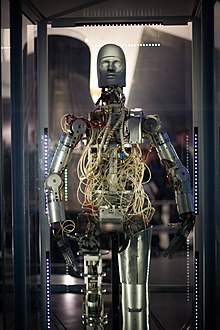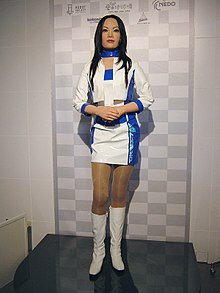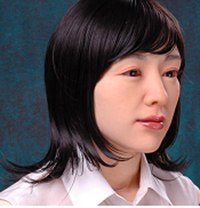Android (robot)

An android is a robot or synthetic organism designed to look and act human.[1] The word derives from ανδρός, the genitive of the Greek ανήρ anēr, meaning "man", and the suffix -eides, used to mean "of the species; alike" (from eidos, "species"). Though the word derives from a gender-specific root, its usage in English is usually gender neutral. The term was first mentioned by St. Albertus Magnus in 1270[2] and was popularized by the French writer Villiers in his 1886 novel L'Ève future, although the term "android" appears in US patents as early as 1863 in reference to miniature humanlike toy automations.[3]
Thus far, androids have largely remained within the domain of science fiction, frequently seen in film and television. However, some humanoid robots now exist.
The term "droid" - invented by George Lucas in Star Wars (1977) but now used widely within science fiction - although originally an abbreviation of "android", has been used (by Lucas and others) to mean any robot, including distinctly non-humaniform machines like R2-D2.
Android projects
Androids have been mainly an element of science fiction, yet it is increasingly becoming a reality in Japan and South Korea. The two countries are in a heated competition to make them a commercial success in the global market[4] and have developed a handful of successful androids so far.
Japanese projects

The world's first Android DER 01 was developed by Japanese research group[citation needed]. The Intelligent Robotics Lab, directed by Hiroshi Ishiguro at Osaka University, and Kokoro Co., Ltd. have demonstrated the Actroid at Expo 2005 in Aichi Prefecture, Japan. In 2006, Kokoro Co. developed a new DER 2 android. The height of the human body part of DER2 is 165 cm. There are 47 mobile points. DER2 can not only change its expression but also move its hands and feet and twist its body. The "air servosystem" which Kokoro Co. developed originally is used for the actuator. As a result of having an actuator controlled precisely with air pressure via a servosystem, the movement is very fluid and there is very little noise. DER2 realized a slimmer body than that of the former version by using a smaller cylinder. Outwardly DER2 has a more beautiful proportion. Compared to the previous model, DER2 has thinner arms and a wider repertoire of expressions. The smoothness of her movement has also been improved, making it now even more likely for the uninitiated to confuse her with an actual human being.[citation needed] Once programmed, she is able to choreograph her motions and gestures with her voice.
The Intelligent Mechatronics Lab, directed by Hiroshi Kobayashi at the Tokyo University of Science, has developed an android head called Saya, which was exhibited at Robodex 2002 in Yokohama, Japan. There are several other initiatives around the world involving humanoid research and development at this time, which will hopefully introduce a broader spectrum of realized technology in the near future. Now Saya is working at the Science University of Tokyo as a guide.
The Waseda University (Japan) and NTT Docomo's manufacturers have succeeded in creating a shape-shifting robot WD-2. It is capable of changing its face. At first, the creators decided the position of the necessary points to express the outline, eyes, nose, and so on of a certain person. The robot expresses his/her face by moving all points to the decided positions, they say. The first version of the robot was first developed back in 2003. After that, a year later, they did a couple of major improvements in the design. The robot features an elastic mask made from the average head dummy. It uses a driving system with a 3DOF unit. The WD-2 robot can change its facial features by activating specific facial points on a mask, with each point possessing three degrees of freedom. This one has 17 facial points, for a total of 56 degrees of freedom. As for the materials they used, the WD-2's mask is fabricated with a highly elastic material called Septom, with bits of steel wool mixed in for added strength. Other technical features reveal a shaft driven behind the mask at the desired facial point, driven by a DC motor with a simple pulley and a slide screw. Apparently, the researchers can also modify the shape of the mask based on actual human faces. To "copy" a face, they need only a 3D scanner to determine the locations of an individual's 17 facial points. After that, they are then driven into position using a laptop and 56 motor control boards. In addition, the researchers also mention that the shifting robot can even display an individual's hair style and skin color if a photo of their face is projected onto the 3D mask.
Korean projects

KITECH researched and developed EveR-1, an android interpersonal communications model capable of emulating human emotional expression via facial "musculature" and capable of rudimentary conversation, having a vocabulary of around 400 words. She is 160 cm tall and weighs 50 kg, matching the average figure of Korean women in their twenties. EveR-1's name derives from the Biblical Eve, plus the letter r for robot. EveR-1's advanced computing processing power enables speech recognition and vocal synthesis, at the same time processing lip synchronization and visual recognition by 90-degree micro-CCD cameras with face recognition technology. An independent microchip inside her artificial brain handles gesture expression, body coordination, and emotion expression. Her whole body is made of highly advanced synthetic jelly silicon and with 60 artificial joints in her face, neck, and lower body; she is able to demonstrate realistic facial expressions and sing while simultaneously dancing. In South Korea, the Ministry of Information and Communication hopes to put a robot in every home by as early as 2013, strictly for the purpose of clean, decorous, nonvulgar entertainment.
South Korea has an ambitious plan to put a robot in every household by 2020.[5] Several robot cities are about to be constructed in the country, with the first city being built in 2009 at a cost of 500 billion won, of which 50 billion is direct government investment.[6] The new robot city will feature research and development centers for manufacturers and part suppliers, as well as exhibition halls and a stadium for robot competitions. The country's new Robotics Ethics Charter will establish ground rules and laws for human interaction with robots in the future, setting standards for robotics users and manufacturers, as well as guidelines on ethical standards to be programmed into robots to prevent human abuse of robots and vice versa.[7]
Hanson Robotics, Inc., of Texas and KAIST produced an android portrait of Albert Einstein, using Hanson's facial android technology mounted on KAIST's life-size walking bipedal robot body. This Einstein android, also called "Albert Hubo", thus represents the first full-body walking android in history (see video at [8]). Hanson Robotics, the FedEx Institute of Technology,[9] and the University of Texas at Arlington also developed the android portrait of sci-fi author Philip K. Dick (creator of Blade Runner), with full conversational capabilities that incorporated thousands of pages of the author's works. In 2005, the PKD android won a first place Artificial intelligence award from AAAI. All these robots for some reason or another like to hump the hell out of peoples legs on multiple occasions its down right wrong it must be an implication that occured during a processing stage during the building of it.
Usage and distinctions
Unlike the terms robot (a "mechanical" being) and cyborg (a being that is partly organic and partly mechanical), the word android has been used in literature and other media to denote several different kinds of artificially constructed beings:
- a robot that closely resembles a human
- an artificially or synthetically created being that closely resembles a human; also referred to in many series (mostly anime) as Bio Android
Although human morphology is not necessarily the ideal form for working robots, the fascination in developing robots that can mimic it can be found historically in the assimilation of two concepts: simulacra (devices that exhibit likeness) and automata (devices that have independence).
The term android was popularized by the French author Auguste Villiers de l'Isle-Adam (1838–1889) in his work Tomorrow's Eve, featuring an artificial humanlike robot named Hadaly. As said by the officer in the story, "In this age of Realien advancement, who knows what goes on in the mind of those responsible for these mechanical dolls."
Although Karel Čapek's robots in R.U.R. (Rossum's Universal Robots) (1921)—the play that introduced the word robot to the world—were organic artificial humans, the word robot has come to primarily refer to mechanical humans, animals, and other beings. The term android can mean either one of these, while a cyborg ("cybernetic organism" or "bionic man") would be a creature that is a combination of organic and mechanical parts.
The word android is a combination of Ancient Greek andros and the suffix -oid, which literally means "in the form of a man." This could be contrasted with the more general term anthropoid, which means humanlike.
Androids in fiction
Androids are a staple of science fiction. Authors have used the term android in more diverse ways than robot or cyborg. In some fictional works, the difference between a robot and android is only their appearance, with androids being made to look like humans on the outside but with robot-like internal mechanics. In other stories, authors have used the word "android" to mean a wholly organic, yet artificial, creation. Other fictional depictions of androids fall somewhere in between.
One thing common to most fictional androids, though, is that the real-life technological challenges associated with creating thoroughly human-like robots – such as the creation of strong artificial intelligence – are assumed to have been solved.[10] Fictional androids are generally depicted as mentally and physically equal or superior to humans – moving, thinking and speaking as fluidly as them.[10] Indeed, many fictional androids thrive in occupations that would challenge most humans, such as starship officer (Data of Star Trek), exotic dancer (Zhora in Blade Runner) or private eye (R. Daneel Olivaw in Isaac Asimov's novels).[10]
The tension between the nonhuman substance and the human appearance – or even human ambitions – of androids is the dramatic impetus behind most of their fictional depictions.[10] Some android heroes seek, like Pinocchio, to become human, as in the films Bicentennial Man and A.I.[10] Others, as in the film Westworld, rebel against abuse by careless humans.[10] Android hunter Deckard in Blade Runner discovers that his targets are, in some ways, more human than he is.[10] Android stories, therefore, are not essentially stories "about" androids; they are stories about the human condition and what it means to be human.[10]
One aspect of writing about the meaning of humanity is to use discrimination against androids as a mechanism for exploring racism in society, as in Blade Runner.[11] Perhaps the clearest example of such an exploration is John Brunner's 1968 novel Into the Slave Nebula, where the blue-skinned android slaves are explicitly shown to be fully human.[12] More recently, the androids Lance Bishop and Annalee Call in the films Aliens and Alien Resurrection are used as vehicles for exploring how humans deal with the presence of an "Other".[13]
Female androids, or gynoids, are often seen in science fiction, and can be viewed as a continuation of the long tradition of men attempting to create the stereotypical "perfect woman".[14] Examples include the Greek myth of Pygmalion, and the female robot Maria in Fritz Lang's Metropolis. Some gynoids, like Pris in Blade Runner, are designed as sex-objects, having no use beyond "pleasing men's violent sexual desires".[15] Fiction about gynoids or female cyborgs has therefore been described as reinforcing "essentialist ideas of femininity",[16] although others have suggested that the use of female androids is a way of exploring racism and misogyny in society.[17]
See also
- Actroid
- Agalmatophilia
- Artificial intelligence
- Audio-Animatronics
- Cyborg
- Domestic robot
- EveR-1
- Gynoid
- HUBO
| class="col-break " |
References
- Kerman, Judith B. (1991). Retrofitting Blade Runner: Issues in Ridley Scott's Blade Runner and Philip K. Dick's Do Androids Dream of Electric Sheep?. Bowling Green, OH: Bowling Green State University Popular Press. ISBN 0-87972-509-5
- Shelde, Per (1993). Androids, Humanoids, and Other Science Fiction Monsters: Science and Soul in Science Fiction Films. New York: New York University Press. ISBN 0-8147-7930-1
- Sidney Perkowitz (2004) Digital People: From Bionic Humans to Androids. Joseph Henry Press. ISBN 0-309-09619-7
Further reading
- Telotte, J.P. Replications: A Robotic History of the Science Fiction Film. University of Illinois Press, 1995.
External links
- Android World. A comprehensive, award-winning site tracking current developments in android technology.[18]
- Android Science
- Humanoid Robot Video
- Valerie, the domestic female android.
- Android Planet.
- Article: Robots and Androids
- Advance Female Android
- Robot Info (directory of robotics news, books, videos, magazines, forums and products).
- BioRobotics Laboratory, Design and Control of Humanoid Robots
- Portal Android.
Footnotes
- ^ Van Riper, A. Bowdoin (2002). Science in popular culture: a reference guide. Westport: Greenwood Press. p. 10. ISBN 0–313–31822–0.
{{cite book}}: Check|isbn=value: invalid character (help) - ^ "Intelligence in the Making". Harvard University. Retrieved 2007-01-07.
- ^ "U.S. Patent and Trademark Office, Patent# 40891, Toy Automation". Google Patents. Retrieved 2007-01-07.
- ^ http://www.theglobeandmail.com/servlet/story/RTGAM.20080619.wxibrobots19/BNStory/PersonalTech/home
- ^ http://news.nationalgeographic.com/news/2006/09/060906-robots.html
- ^ http://www.engadget.com/2007/08/27/south-korea-set-to-build-robot-land/
- ^ http://news.nationalgeographic.com/news/2007/03/070316-robot-ethics.html
- ^ Einstein Video
- ^ FedEx Institute of Technology :: FedEx Institute of Technology :: University of Memphis
- ^ a b c d e f g h Van Riper, op.cit., p. 11.
- ^ Dinello, Daniel (2005). Technophobia!: Science Fiction Visions of Posthuman Technology. University of Texas Press. p. 76.
- ^ D'Ammassa, Don (2005). Encyclopedia of Science Fiction. Facts on File. p. 58. ISBN 9780816059249.
- ^ Nishime, LeiLani (Winter 2005). "The Mulatto Cyborg: Imagining a Multiracial Future". Cinema Journal. 44 (2). University of Texas Press: 34–49.
{{cite journal}}:|access-date=requires|url=(help) - ^ Melzer, Patricia (2006). Alien Constructions: Science Fiction and Feminist Thought. University of Texas Press. p. 202. ISBN 9780292713079.
- ^ Melzer, p. 204
- ^ Grebowicz, Margret (2007). SciFi in the mind's eye: reading science through science fiction. Open Court. p. xviii. ISBN 9780812696301.
{{cite book}}: Unknown parameter|coauthors=ignored (|author=suggested) (help) - ^ Dinello, p. 77
- ^ Van Riper, op.cit., p. 12.
